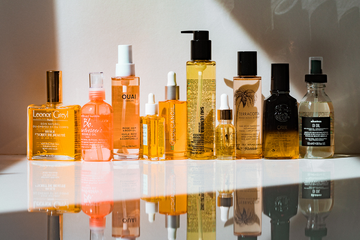Discover the sweet spot for your strands
Craving hair that's so good, it's almost scandalous? Well, hair oiling is the Gossip Girl of hair care routines—it knows everything about getting those luscious locks.
What was once an age-old tradition in South Asian and African cultures is now the talk of the For You Page, thanks to TikTok influencers blowing up its spot.
But here's the tea: hair oiling isn't as simple as slapping on some oil and calling it a day. Too much, and you're channeling a 90s boy band. Too little, and your hair's thirstier than you after a spin class.
So, how often should you oil your hair—when you’re not going for the wet look, that is? Read on, as we’re dishing on the ancient wisdom behind this beauty ritual, decoding its modern-day benefits, and finally revealing the magic number for oiling your hair to perfection.
Get ready to transform your tresses and unlock the ultimate hair glow-up. XOXO.
HighlightsWhat is hair oiling?Benefits of hair oilingTypes of hair oilsHow often should you oil your hair?How to oil your hairFAQsThe takeaway |
What is hair oiling?
Hair oiling is essentially a deep conditioning treatment where you massage oil into your scalp and hair. It’s a direct shot of nourishment and hydration, leaving your strands feeling revitalized and looking their absolute best.
This age-old practice has deep roots in various cultures, particularly in South Asia and Africa, where it's been used for centuries to promote hair health and growth. But now, thanks to social media and its ability to turn niche beauty rituals into global trends, hair oiling is everywhere. From your favorite influencer's GRWM routine to your cousin's tried-and-true hair care hack, everyone seems to be on board the hair oiling train.
And for good reason! Hair oiling isn't just about aesthetics; it's about giving your hair the TLC it deserves. It can strengthen your strands, reduce frizz, and even combat dandruff. Basically, it’s the ultimate multi-tasker for your hair care routine, but more on that later.
Now, before you go dousing your head in whatever oil you find in the pantry, let's get a few things straight. Hair oiling isn't a one-size-fits-all situation. The type of oil you use, how often you apply it, and your hair type all play a role in getting those influencer-worthy results. But don't worry, we'll break it all down for you, step by step.
The benefits of hair oiling
Alright, now that you know the what of hair oiling, let's explore the why (all before answering your question: how often should I oil my hair?”). While the specific benefits can vary depending on the type of oil you choose, here are some general perks you can expect from incorporating this ritual into your routine:
Hydration station
Hair oiling is like a tall glass of water for your thirsty strands. It’s a must if you’re frequently using heat products on your hair, since oils help lock in moisture, leaving your locks feeling soft, supple, and oh-so-touchable. Say goodbye to dry, brittle hair and hello to a mane that's hydrated and happy.
Frizz fighter
If your hair tends to resemble a lion's mane on humid days, hair oiling can be your savior. Oils help smooth the hair cuticle, taming frizz and flyaways for a sleek, polished look.
Scalp soother
A healthy scalp is the foundation for healthy hair. Massaging oil into your scalp can help improve blood circulation, nourish hair follicles, and even reduce dandruff and itchiness. It's like a mini-massage for your head, with added hair benefits.
Strength training
Oils can help strengthen your hair, reducing breakage and split ends. This means longer, healthier hair that can withstand all your styling adventures.
The types of hair oils and their benefits
Now that you know the general benefits, let's get specific. Here’s a quick rundown of some popular hair oils and their unique superpowers:
Coconut oil
A true haircare hero, coconut oil deeply penetrates the hair shaft, moisturizing, strengthening, and helping prevent protein loss. It's like a protective shield for your strands, keeping them healthy and resilient.
Who might use it: Those with dry, damaged, or frizzy hair will adore coconut oil's intense hydration. It's also a great choice for anyone looking to add shine and tame unruly curls.
Argan oil
Dubbed ‘liquid gold’, argan oil is rich in antioxidants and fatty acids that nourish and protect hair. It adds a gorgeous shine, smooths frizz, and even helps protect against heat damage.
Who might use it: Argan oil is a versatile option suitable for all hair types. Its lightweight texture makes it a great choice for those with fine or oily hair who want the benefits of oil without the heaviness.
Jojoba oil
Jojoba oil is a bit of a hair chameleon—it closely resembles the natural oils produced by your scalp, helping to balance oil production and moisturize without weighing hair down. It can even help soothe an itchy or irritated scalp.
Who might use it: Those with oily or acne-prone scalps will appreciate jojoba oil's balancing properties. It's also a good choice for those with dry hair who want a lightweight moisturizer.
Castor oil
This thick and rich oil is a powerhouse for promoting hair growth and thickness. It also deeply moisturizes and soothes the scalp, making it a great option for anyone dealing with dryness or flakiness.
Who might use it: If you're looking to boost hair growth or combat thinning hair, castor oil is your go-to. It's also beneficial for those with dry scalps or dandruff.
Olive oil
A kitchen staple that doubles as a haircare gem, olive oil is rich in antioxidants and Vitamin E. It helps soften hair, add shine, and protect against damage.
Who might use it: Olive oil is ideal for those with dry or damaged hair. It’s particularly effective for taming frizz and adding moisture to coarse or thick hair.
Almond oil
Lightweight and easily absorbed, sweet almond oil softens hair, adds shine, and helps detangle knots. It's also rich in Vitamin E, which nourishes and protects the scalp.
Who might use it: Those with fine or delicate hair will love sweet almond oil's gentle touch. It's also great for anyone struggling with tangles or scalp dryness.
Grapeseed oil
Another lightweight option, grapeseed oil is rich in antioxidants and linoleic acid. It helps moisturize hair, reduce frizz, and even protect against heat damage.
Who might use it: Grapeseed oil is suitable for all hair types, especially those prone to frizz or heat styling. Its non-greasy formula makes it a good choice for those with oily scalps.
Remember, this is just a sampling of the amazing oils out there. Don’t be afraid to experiment and find your hair's perfect match!
How often should you oil your hair?
Now, for the million-dollar question: how often should you oil the ends of your hair? The truth is, there's no one-size-fits-all answer when it comes to hair oiling frequency. Think of it like dating: you need to find the right rhythm with your hair, and that depends on a few factors:
Factor 1: Your hair type
– Dry hair: If your hair is constantly parched, aim for oiling 1-2 times a week. This will help lock in moisture and keep those strands hydrated and happy.
– Oily hair: If your scalp is an oil slick by midday, you might want to take it slow. Once a week or even every other week should be sufficient to reap the benefits without feeling greasy.
– Normal hair: Lucky you! You've got the hair care equivalent of a balanced diet. Oiling once a week should keep your hair looking and feeling its best.
Factor 2: The type of oil you’re using
– Heavy oils (like coconut or castor oil): These oils are deeply nourishing but can also be a bit heavy. Use them less frequently, especially if you have fine or oily hair.
– Lightweight oils (like argan or jojoba oil): These oils are easily absorbed and less likely to weigh hair down. You can generally use them more frequently, even if you have oily hair.
Factor 3: Your hair goals
– Combating dryness and frizz: If your main concern is dryness and frizz, oiling 1-2 times a week will help lock in moisture and smooth those unruly strands.
– Promoting hair growth: If you're looking to boost hair growth or thickness, castor oil is your friend. Use it 1-2 times a week, focusing on the scalp.
– General hair health: If you want to maintain overall hair health and add shine, any of the oils mentioned above can be beneficial. Start with once a week and adjust as needed.
Keep in mind that these are just guidelines. Pay attention to your hair’s signals. If it starts feeling greasy or weighed down, you might be overdoing it. On the other hand, if your hair still feels dry and brittle, you might need to oil more frequently.
The key is to find what works best for you and your unique hair type. It might take a bit of experimentation, but trust us, it's worth it—just look at these INSANE hair oiling transformations.
How to oil your hair (step-by-step guide)
Okay, you've got the oil, you're ready to reap the benefits, but now what? Don't worry, oiling your hair is easier than perfecting your winged eyeliner (well, almost). Here's a simple step-by-step guide to get you started:
1. Choose your oil
We've revealed what you need to know about the different hair oils, so pick one that suits your hair type and goals. Remember, lighter oils are great for frequent use, while heavier oils are best for deeper treatments.
2. Warm it up
Gently warm the oil by placing the bottle in a bowl of warm water for a few minutes. Warm oil is easier to apply and helps penetrate the hair shaft better. But don't go overboard – you don't want to fry your scalp!
3. Part and conquer
Divide your hair into sections to ensure even application. Start by applying the oil to your scalp, massaging it in with your fingertips using gentle, circular motions. This helps stimulate blood flow and ensures the oil reaches your hair follicles.
4. Work your way down
Once your scalp is coated, work the remaining oil through the lengths of your hair, focusing on the ends. If you have oily hair, you might want to avoid applying oil directly to your roots.
5. Wrap it up
Cover your hair with a shower cap or warm towel to help the oil penetrate deeper. Leave it on for at least 30 minutes, or even overnight for a more intensive treatment.
6. Wash and go
Shampoo your hair thoroughly to remove the oil. You might need to shampoo twice, especially if you used a heavier oil. Follow up with your usual conditioner.
✨ TYME tip ✨Don't be afraid to experiment! You can add a few drops of essential oils to your chosen hair oil (which serves as your carrier oil) for added benefits. For example, rosemary oil is believed to stimulate hair growth and improve circulation to the scalp. Curious about how often to use rosemary oil for hair growth? We recommend starting with 2-3 times a week and adjusting based on your results. |
How often should you oil your hair? The takeaway
So, to oil or not to oil? That's not the question. The real question is, how often? As we've seen, there's no one-size-fits-all answer. Your hair type, oil choice, and hair goals all play a role in finding your perfect frequency. But as a general rule of thumb, 1-2 times per week seems to be the optimal frequency.
We recommend listening to your hair, though! If it feels greasy, dial back the oiling. If it's still thirsty, amp up the frequency. With a little experimentation and mindful observation, you'll find the sweet spot that leaves your hair looking and feeling its absolute best.




